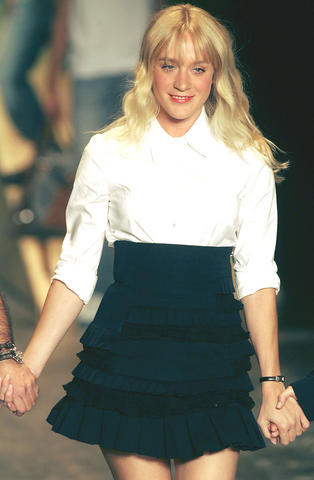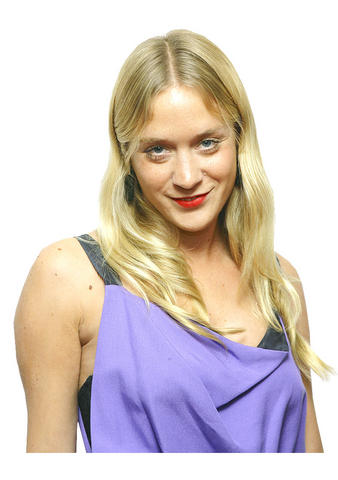It's a savagely cold December afternoon in Manhattan, and the wind could freeze the tears in your eyes. I'm with the actor Chloe Sevigny, driving at a crawl to a photo shoot where she will model outfits from her first clothing line, which she has designed for downtown boutique Opening Ceremony. The line is a charmingly sincere ragbag of patterns and influences, inspired by the "clothes collages" Sevigny would throw together as a bored adolescent in the commuter suburb of Darien, Connecticut. Nothing ever happened in Darien. Sevigny has claimed she would yell every night at her parents, "I can't believe you're bringing me up here! You guys are, like, evil!" Entire afternoons were whiled away watching her older brother, Paul, and his pals skateboarding in the backyard. Mostly, she sewed. "I had nothing better to do, so I made my own clothes."
Moonlighting at Opening Ceremony has brought her full circle. "I just came up with stuff I'd want to wear," she trills in a tra-la-la voice. "A little quirky and funky. Pretty classic, but with a twist. I was thinking about Neneh Cherry, the New Wave bands I was into in junior high, the boys I knew who liked the early hip-hop scene. It's a mishmash of alternative things that suburban kids were into. When you're young, you're mixing things up. You're a sponge. The Opening Ceremony stuff is like me going back to my youth. My last hurrah."
Although it's her first stint as a designer, Sevigny was previously responsible for the thrift-store look of the 1997 film Gummo, her then-boyfriend Harmony Korine's spaced-out ode to white-trash America. She made swimsuits and pink felt bunny ears that she ran up on her sewing machine. She also appeared in the film. You couldn't miss her: she was the one with albino-blond hair and eyebrows, and electrical tape on her nipples. Other actors could have played the part, but none could have looked so spookily blithe or blaze.

PHOTO :AP
Sevigny has been acting for 13 years, but it's still impossible to take her face for granted. There is no one in US cinema who looks like her, no one with the same mash up of feline beauty and loutish toughness. "She's one of those cases where you turn on the camera and she changes instantly," says Kimberly Peirce, who directed her in Boys Don't Cry. "My director of photography looked at me in astonishment because the second the camera started rolling, she became this other creature, this thing the camera loves. With some actors you have to keep them active or they don't sustain your interest. But Chloe doesn't have to do anything and she will still command your attention."
Although the 33-year-old Sevigny is tall and slender in tight, dark jeans, black boots and baggy leather jacket, she walks with a slight galumphing awkwardness, planting her feet purposefully as she goes. Her face is long and elegantly pointed, offset by a formidable jaw on which you could crack open a bottle of beer. Her droopy-lidded eyes can lend her a docile vagueness, which came in handy during an early run of movies set in the white-trash hinterland (Gummo, Boys Don't Cry, Julien Donkey-Boy), in which she played characters for whom a move to the ass end of nowhere would have represented unimaginable social promotion.
As we inch through the gridlock, she becomes antsy, eventually suggesting to the driver that we may be heading the wrong way. He phones his boss, who confirms this to be the case. "Why did they give me wrong directions?" he wonders. Sevigny slumps back in her seat and glares out of the window. "So that we get there late," she replies, seething quietly, "and then they can make me work all night." Well, it's a theory.

PHOTO :AP
Earlier that day, over lunch, she is frank about her disdain for the lucrative modeling gigs - Miu Miu, Dolce & Gabbana, H&M - that not only pay her bills but could also settle those of most of her East Village neighbors. "The shoots can go on, like, for ever," she complains, sinking a fork into her salmon terrine. She used to worry that modeling diminished her as an actor in people's eyes, "but the lines are blurred now. Look at Charlize Theron - she's done so many ads." I ask if there isn't a side to modelling that makes her uncomfortable. "Oh, like the selling out, you mean?" She gives a wheezy, high-pitched laugh that sounds like a tent being unzipped at high speed. "Yeah, that's not so much fun. But fashion is a good way for me to make a living. I couldn't survive just doing independent movies. And I'd rather do modeling than movies or TV I didn't like."
That's one of the most striking elements of Sevigny's acting resume: nothing on it looks mercenary, from her debut 13 years ago in the ostentatiously controversial Kids to her current success in the HBO series Big Love, in which she plays Nicolette, the most devious of a Salt Lake City Mormon fundamentalist's three wives. She will typically choose a project, she says, because she admires the director, which has resulted in quite a roll call: Lars von Trier, Woody Allen, David Fincher, Jim Jarmusch, Olivier Assayas, Whit Stillman. "Chloe's ahead of the curve because she's aware of the curve," actor/director Vincent Gallo said in 2004. "Most actors wouldn't know an interesting filmmaker if they fell on them, but Chloe creates opportunities to work with people she likes."
Right now, she should be slipping back into a prairie skirt to shoot the third season of Big Love, but the Hollywood writers' strike has put paid to that. It's not all bad news. "Playing Nicolette 10 hours a day for six days is not the most positive place to be," she groans. "I keep asking them, 'Can't you give me a vulnerable scene to play? I'm sick of being the bitch.' I need a little, you know, color." Her voice wanders up and down the register, hitting unexpectedly shrill or gravelly notes.
All this time off is giving Sevigny a chance to think about where her career is going. She has been complaining for years that she wants to shake off the "indie girl" tag that is becoming her ball and chain, but she keeps sending audition tapes out to Los Angeles and getting nothing back. "Partly, it's a girl problem," says Christine Vachon. "There still aren't enough female roles. But it may also be that people associate Chloe with an edgier, more original type of film."
To be fair to Hollywood, Sevigny may be sending out mixed messages. While she gripes about being turned down for parts in Mona Lisa Smile and Mr and Mrs Smith, and says she came very close recently to "a couple of big things that didn't work out," she is also known as the woman who declined a US$500,000 supporting role in Legally Blonde. When he heard this, her brother, a DJ and bar-owner who lives a few streets away, didn't speak to her for three weeks.
When she talks about her desire for high-profile roles, Sevigny takes on an indignant edge. "There's this index that tallies up how much your movies have made, and if they haven't grossed a certain amount, then you're not bankable. I know I'm not Will Smith but, you know, my ranking's pretty low. The only studio picture I've done is Zodiac, and that didn't perform that well." I start to congratulate her on Zodiac all the same: it was just the "girlfriend" part on paper, but she brought it expertly to life. Unfortunately, she interrupts me after the first half of that sentence: "I know, I know, it was just the girlfriend," she blathers apologetically, "but I'd never taken that kind of part before, so ... ."
It's disarming how readily she will sell herself short. Her allure hinges on the easy-going confidence she clearly has in spades and which makes those around her feel more relaxed simply for being in her vicinity. You can tell she enjoys herself: she laughs readily, and has a nice line in humorous mannerisms - lowering her face, then looking up with raised eyebrows to express disapproval, or opening her eyes and mouth extravagantly wide to register outrage. But there's an undercurrent of insecurity that manifests itself in anecdotes that often end with her being ignored or humiliated, such as a story about a Morrissey fan site that lays into her whenever she is seen at one of the singer's shows. "They always make fun of me," she says sadly. "They hate me, they're really nasty." Last Halloween, she dressed as Joan of Arc from the Smiths song Bigmouth Strikes Again, complete with Walkman. "Except that the Sony ones are really hard to find, so I had a Panasonic. And on the Web site, they said, 'Oh, a Panasonic isn't really a Walkman.' They're such nit-pickers." She went to see Morrissey play in Miami recently, and saw the Web site's manager by the hotel pool. "I tried to engage him in civilized conversation - you know, love your enemies - but I don't think he was interested." She collapses in embarrassed laughter.
Although Sevigny has figured in every Best Dressed or Most Stylish list published in the past decade, she maintains that people make fun of what she wears. "They think, 'Oh, she's the one with the funky fashion.'" (That's "funky" in the pejorative sense, she points out, "odd" rather than "groovy.") When I ask what impression she thinks Hollywood has of her, she replies immediately: "I think they think I'm a good actress. I don't want to sound self-pitying, but maybe it's a looks thing, like they don't think I'm pretty enough. I always feel I could be like Toni Collette, going between big studio things and indie films. That would be feasible."
Until now, things have been perfect. She has respect, integrity, an outstanding body of work to her name and an Oscar nomination (for Boys Don't Cry). In the early 1990s, she couldn't walk a few blocks in Manhattan without causing a stir. The novelist Jay McInerney heralded her as a "downtown trendsetter" and wrote Chloe's Scene, a florid seven-page article in the New Yorker. He interviewed her friends, followed her to clubs, proclaimed her the new It-Girl (which she hated). She agreed to it on the promise of a rubberized Helmut Lang dress that never materialized. At the same time, her film career was taking off. She had left Darien for New York, where she became part of the Washington Square Park skate-punk crowd out of which Kids was born. Sevigny and her friends, including Korine, had attracted the attention of the photographer Larry Clark. When Clark was preparing to shoot Kids - Korine's script about drug-dazed, HIV-infected teenage ne'er-do-wells - she landed a minor role, but found herself promoted when the lead balked at the prospect of nudity.
"Larry called me," remembers Christine Vachon, who has produced four of Sevigny's films, including Kids and Boys Don't Cry, "and said, 'You know what? It should've been Chloe all along." Sevigny played Jennie, whose roster of traumas includes becoming infected with HIV after having sex for the first time, and being raped while catatonic. (She shrugged off that scene, the movie's grim climax, at the time: "I just let my body go limp. The actor did all the work.") Her on-screen achievements were clear: Sevigny provided the warm, reflective center in this feral film. But behind the scenes she was doing her bit, too, encouraging Korine to work harder at writing interesting female characters.
"Kids was an exciting time," she says. "I wasn't thinking about Hollywood. I didn't care about the long haul, the big picture. It was so freeing." The roles came slowly after that, but they were all peaches. One of the juiciest was the gauche wannabe who gets the clap in Whit Stillman's crisp comedy The Last Days of Disco. "Chloe is a natural phenomenon," Stillman has said. "You're not directing, she's not performing - it's just real."
It was a performance that convinced Kimberly Peirce to cast her in Boys Don't Cry, the true story of Teena Brandon, a Nebraska lass who renamed herself Brandon Teena and romanced the karaoke-singing factory worker Lana Tisdel, before being exposed, raped and murdered. Sevigny wanted the lead. Peirce couldn't see her as a man, and Sevigny stubbornly refused to audition. But Pierce boned up on her back catalogue, just to be sure. "There's a moment in The Last Days of Disco when Chloe does this little dance move and flirts with the camera," she says. "She has this mix of attractiveness, flirtation and sophistication that she gives you, but then takes away very quickly so that you want more: you want to reach into the screen and grab her. When I saw that, and her confidence and wit, I thought: if she could flirt with Brandon and the audience in that way, that's exactly what we need for Lana. I said to her, 'Will you please audition to play Lana?' She said, 'No.' And I said, 'OK, you can have the role.'"
As Brandon, Hilary Swank had the limelight (and got the Oscar), but the film would fall apart without Sevigny's Lana, who drifts through the dismal bars, parking lots and clapboard houses of small-town Nebraska like an extraterrestrial who's given up waiting for the mother ship to come back to claim her. No other director has displayed such sensitivity toward her physical oddness - Peirce lets her vast face and slow-motion eyes swamp the screen, not least in a celebrated sex scene that focuses entirely on Lana's face as Brandon brings her to orgasm.
"Filmmakers don't always show female pleasure," Peirce says, "and they rarely celebrate it. But Brandon lived for Lana's pleasure, so it was important to me that the audience felt that. If you're going to show an orgasm, you should make it orgasmic. Hilary and Chloe had asked me to treat the sex scenes like fighting or dancing scenes. They said, 'Tell us exactly what to do, we don't want to improvise.' Then I asked Chloe, 'Shall we talk through the orgasm, too?' and she said, 'No, Kim, I think I know what you want.'" In fact, Sevigny's depiction of pleasure was so unfettered that it left the US censor threatening a prohibitive rating.
"I need another part like that," Sevigny says as we finally pull up outside the studio. "Something where I can shine." And it was a boost to be nominated for the Best Supporting Actress Oscar, even though she said at the time, "I don't even feel like it would be a good thing if I got it - it feels too early."
Sevigny has done fine work since Boys Don't Cry, in Lars von Trier's Dogville and Woody Allen's Melinda and Melinda, but it's outrageous that she hasn't been offered another meaty part. Typically, she adds more to a film than it adds to her. It may be a problem that she and Korine drifted apart, though she looks aghast when I ask if she needs another Harmony. I point out that I mean artistically, rather than romantically: someone who knows her range and writes her bespoke parts. She likes the sound of that - "Like Hanna Schygulla and Fassbinder," she says dreamily. Sevigny and Korine split up before the latter cleaned up his act. Now she will say only that, "We're not in touch." A clean break? "More like a big messy one."
Earlier, when Sevigny was bemoaning Hollywood's lack of interest in her, I asked if it might be wise to spend a month in Los Angeles attending auditions, lobbying for parts. "One thinks one would," she giggled, self-deprecatingly. "No, you're right, I have to put in more effort. But whenever I make those plans, they just ... fall apart."
Maybe she doesn't want it badly enough. Or perhaps she realizes, like the rest of us, that Hollywood needs her, not the other way around. It just doesn't know it yet.

A vaccine to fight dementia? It turns out there may already be one — shots that prevent painful shingles also appear to protect aging brains. A new study found shingles vaccination cut older adults’ risk of developing dementia over the next seven years by 20 percent. The research, published Wednesday in the journal Nature, is part of growing understanding about how many factors influence brain health as we age — and what we can do about it. “It’s a very robust finding,” said lead researcher Pascal Geldsetzer of Stanford University. And “women seem to benefit more,” important as they’re at higher risk of

March 31 to April 6 On May 13, 1950, National Taiwan University Hospital otolaryngologist Su You-peng (蘇友鵬) was summoned to the director’s office. He thought someone had complained about him practicing the violin at night, but when he entered the room, he knew something was terribly wrong. He saw several burly men who appeared to be government secret agents, and three other resident doctors: internist Hsu Chiang (許強), dermatologist Hu Pao-chen (胡寶珍) and ophthalmologist Hu Hsin-lin (胡鑫麟). They were handcuffed, herded onto two jeeps and taken to the Secrecy Bureau (保密局) for questioning. Su was still in his doctor’s robes at

Last week the Democratic Progressive Party (DPP) said that the budget cuts voted for by the China-aligned parties in the legislature, are intended to force the DPP to hike electricity rates. The public would then blame it for the rate hike. It’s fairly clear that the first part of that is correct. Slashing the budget of state-run Taiwan Power Co (Taipower, 台電) is a move intended to cause discontent with the DPP when electricity rates go up. Taipower’s debt, NT$422.9 billion (US$12.78 billion), is one of the numerous permanent crises created by the nation’s construction-industrial state and the developmentalist mentality it

Experts say that the devastating earthquake in Myanmar on Friday was likely the strongest to hit the country in decades, with disaster modeling suggesting thousands could be dead. Automatic assessments from the US Geological Survey (USGS) said the shallow 7.7-magnitude quake northwest of the central Myanmar city of Sagaing triggered a red alert for shaking-related fatalities and economic losses. “High casualties and extensive damage are probable and the disaster is likely widespread,” it said, locating the epicentre near the central Myanmar city of Mandalay, home to more than a million people. Myanmar’s ruling junta said on Saturday morning that the number killed had